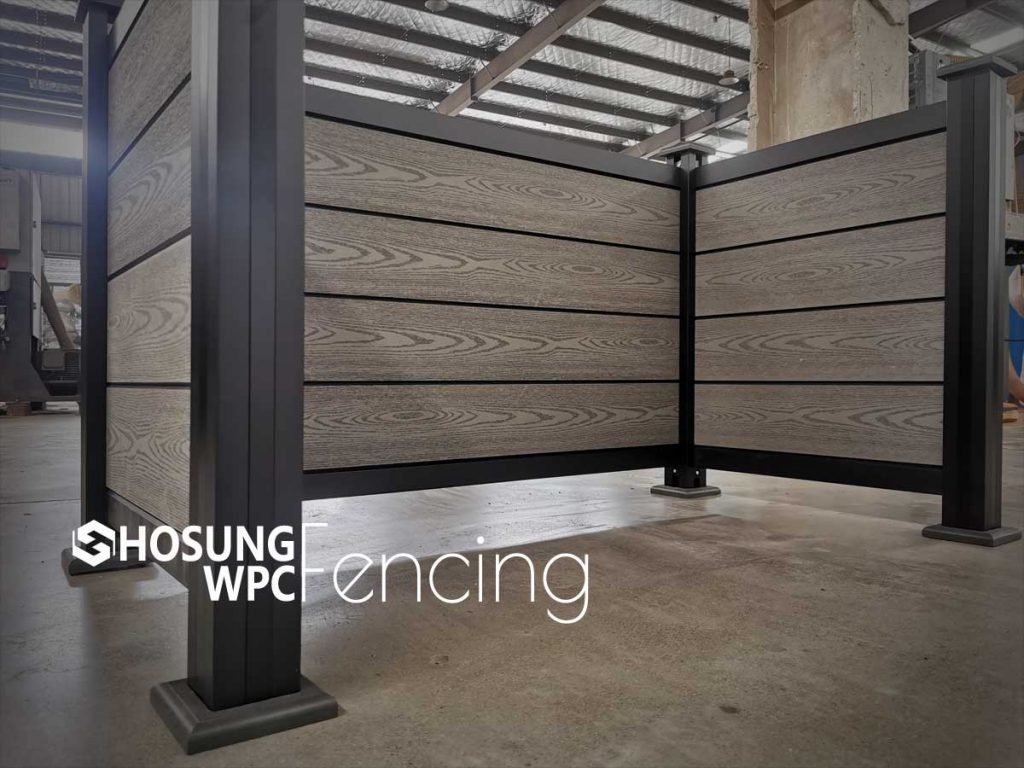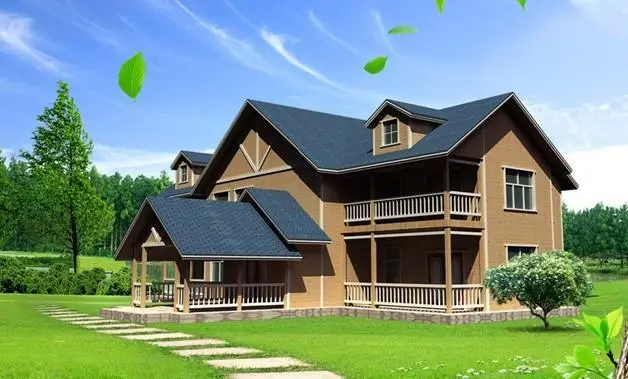Decking is a transformative addition to your outdoor living space and has been chosen by many people for centuries. But traditional wooden decking brings a lot of problems, such as splinter, rot, crack. Fortunately, a modern solution has emerged in recent decades: composite decking.
With its durability and aesthetic appeal, composite decking addresses these challenges, creating endless opportunities for landscaping, furniture, lighting, and decor. It effortlessly integrates with your lifestyle, enhancing your home’s allure and value.
Now, let’s delve into the world of composite decking. We’ll explore materials, production, choosing the finest boards, cost comparisons, and the intricacies of installation and maintenance. Ready to get started on your outdoor oasis?
Table of Contents
What Is Composite Decking and What Is It Made Of?
Composite decking is short for wood plastic composite decking. WPC decking is another popular name for it. Besides, somebody may also call it composite timber decking, engineered wood decking, or synthetic wood decking.
Typically, composite deck boards consist of a mix of reclaimed wood fiber, both virgin and recycled plastic, along with various chemical additives.
The wood fiber, comprising 50-70% of composite decking, is usually sourced from common wood types like maple, oak, and pine, obtained from sawdust and readily available wood scraps. Some manufacturers may opt for bamboo and straw as alternative wood components.
WPCs can be manufactured from either virgin or recycled thermoplastics, with high-density polyethylene (HDPE), low-density polyethylene (LDPE), polyvinyl chloride (PVC), polypropylene (PP), acrylonitrile butadiene styrene (ABS), polystyrene (PS), and polylactic acid (PLA) being among the commonly used materials. PE-based WPCs are the most prevalent in the industry.
To tailor the end product to specific applications, manufacturers incorporate chemical additives like colorants, coupling agents, UV stabilizers, blowing agents, foaming agents, and lubricants. These additives play a crucial role in optimizing the composite’s performance and appearance.
What’s the History of Composite Decking?
The history of composite decking is a fascinating journey that reflects the innovation and evolution of materials in the construction industry. Composite decking was born out of a desire to create a low-maintenance alternative to traditional wood decking while still retaining the aesthetic appeal of natural wood.
The concept of composite decking dates back to the early 1990s when manufacturers began experimenting with combining wood fibers or wood flour with thermoplastics like polyethylene. This experimentation resulted in the development of the first generation of composite decking boards, which, although durable and low-maintenance, had issues with color fading and surface deterioration.
Over the years, continuous research and development efforts led to significant improvements. Second and third-generation composite decking introduced co-extrusion technology, cap layers, and enhanced additives, addressing many of the earlier issues. These advancements enhanced the longevity, color retention, and overall performance of composite decking.
Today, composite decking has become a popular choice for homeowners, known for its durability, resistance to rot and insects, and low maintenance requirements. Its history is a testament to the industry’s commitment to creating sustainable and aesthetically pleasing outdoor decking solutions.
What Are the Features of Composite Decking?
Pros
- Composite decking is highly durable
The core material of composite decking usually consists of plastic and wood fibers, which allows composite decking to embrace the both advantages of wood and plastic. WPC composite decking has strong water, stain, and mold/mildew resistance and does not crack, splinter, or warp like traditional wood decking. It also has a longer service life, which is 3-5 times longer than wood decking in average. - Wood plastic flooring comes with diverse options
Composite decking comes in a variety of colors with diverse texture styles and leaves consumers with endless choosing space. There are many different authentic wood grains and colors available on the market, which can even be customized according to customer requirements to meet different home styles. - Composite WPC decking also has environmental advantages.
To produce traditional solid wood decking, the manufacturers have to cut down a large number of trees, resulting in severe deforestation. However, WPC decking boards use recycled wood and plastic as raw materials and never have to cut down a single tree, which has less impact on the environment. - Composite decking is extremely easy to clean and maintain
WPC decking does not require regular staining, painting, or oiling like solid wood decking. A simple soap-and-water clean is all it takes. So you can enjoy more on your decking.
Cons
Composite wood decking usually comes with a higher price than traditional wood decking, leaving people struggling to choose between the two options. While advancements have been made in the manufacturing process of WPC decking, allowing it to better imitate the texture and color of wood decking, differences remain due to the plastic components. The weight of plastic wood can also be a challenge during transportation and installation.
How Many Types Does Composite Decking Have?
Decking Structure: Solid vs. Hollow Composite Decking
Composite decking can be classified into two primary categories based on their structural composition: Solid Composite Decking and Hollow Composite Decking, each with distinct attributes to suit various preferences and applications.
01. Solid Composite Decking: Enduring Strength
Solid composite boards are known for their substantial weight and sturdy construction, symbolizing reliability and permanence. They seamlessly fit into residential and commercial settings, offering exceptional strength and durability. Solid composite decks are an excellent choice for high-traffic areas like swimming pool decks and residential walkways. Due to their weight and complexity, professional assistance is recommended for installation.
02. Hollow Composite Wood Decking: Lightweight Versatility
In contrast, hollow composite decking provides a lightweight and flexible alternative. They excel in applications such as cable installation, cladding, and siding due to their adaptability. Although they may be slightly less impact-resistant, their versatility shines. It’s worth noting that achieving a polished finish with hollow composite decking requires the use of caps or fascia boards along their edges.
Decking Technology: Capped Vs. Uncapped Composite Decking
The production technology of composite decking further divides it into two distinct categories: uncapped wood composite and capped composite wood decking. Familiarizing oneself with these variations sheds light on their performance and resilience against external elements.
01. Capped Composite Decking: Ultimate Protection and Durability
Capped composite wood decking, often referred to as second-generation WPC decking, features a protective plastic layer on its surface. This layer not only safeguards the internal core materials but also enhances resistance against oil stains, scratches, and discoloration. Capped composite boards are the preferred choice for areas exposed to heavy wear, tear, and varying weather conditions, including outdoor walkways and poolside areas.
02. Uncapped Composite Decking: Budget-Friendly Option
Known as first-generation boards, uncapped composite wood decking closely emulates the natural texture of wood on its surface. While not entirely unaffected by oil stains, they outperform raw wood and are relatively easy to clean. Dust and stains can be removed with water, while more stubborn oil or ink marks can be tackled with hot soapy water.
Decking Texture: Classic Vs. 3D Embossed Texture
The texture of composite decking plays a crucial role in aesthetics and longevity, with two primary options to consider: classic texture and 3D embossed texture.
01. Classic Texture: Simple Elegance with Limited Lifespan
Classic texture decks offer straightforward elegance that complements various outdoor designs. However, it’s important to note that this charm may fade relatively quickly due to wear and tear, as well as exposure to the elements.
02. 3D Embossed Texture: Beauty Beyond Time
For those seeking enduring charm, 3D embossed texture composite decks are the solution. This texture adds depth and dimension to your outdoor space, creating a visual masterpiece that stands the test of time. Unlike traditional textures that degrade over time, the 3D embossed texture maintains its allure year after year, defying wear and tear. It’s not just a surface; it’s a testament to lasting beauty.
How Much Does a Composite Decking Cost?
Wondering about the cost of composite decking? We’ve got you covered. The average cost for a new composite decking installation is around $8,900. However, prices can vary, typically falling between $5,200 and $11,000, depending on factors like size and complexity. More elaborate designs can even reach up to $25,000, while smaller, simpler decks may cost as little as $3,500.
Cost Estimation by Deck Size
Most decks are roughly 30-40 square meters in size, with composite decking costs averaging between $24 and $48 per square foot. For more precise cost estimates based on different deck sizes, check out the chart below.
Factors That Influence Cost
Several factors can impact the total cost of your composite decking project:
- Decking Material: The quality of the materials used can affect costs. On average, composite decking alone costs between $4.50 and $13 per square foot.
- Decking Brand: Brand names can also influence prices. Trusted brands like Trex, AZEK, and HOSUNG, which often come with a higher price tag, tend to have a strong track record of satisfied customers.
- Decking Shape: The shape of your deck matters too. Simple shapes like rectangles are more budget-friendly, while complex designs with numerous angles and sides require more labor and materials, increasing costs.
- Site Preparation: Preparing the construction site may involve additional costs, such as land clearing (typically $100 to $735 for a quarter acre), removing an existing deck (around $5 to $10 per square foot), and land leveling and grading (ranging from $800 to $4,000).
- Add-Ons and Features: Many homeowners choose to enhance their composite decks with various add-ons:
- Hidden fasteners offer a seamless look but come at a higher cost (about twice that of standard fasteners).
- Railings are a popular addition, typically costing $25 to $30 per linear foot.
- Adding electricity to your deck can be done with DIY kits for as low as $30, but professional installation by an electrician may cost between $45 and $100 per hour.
- Deck lighting for nighttime enjoyment usually ranges from $1,700 to $3,000.
- Fire pits, providing heat and ambiance, generally cost $250 to $2,200.
- Pergolas, offering partial shade with a grid-style roof, typically range from $2,100 to $6,000.
- Gazebos, providing full shade and protection with solid roofs, can vary from $5,365 to $9,025.
Keep these factors in mind when planning your composite decking project to ensure a clear understanding of the associated costs.
How to Install Composite Decking?
If you’re a DIY enthusiast, our easy-to-follow guide will help you install composite decking with confidence, turning your outdoor space into a serene retreat.
Step 1: Building a Solid Foundation
Plan and Measure: Begin by taking precise measurements and preparing the ground. If additional support structures are needed for your composite decking, ensure they are in place.
Frame Construction: Lay out the framework according to your measurements, maintaining even spacing between composite decking joists (usually around 16 inches, but anywhere from 12 to 24 inches can work). Consider joist thickness for added stability.
Secure the Frame: Connect the joists securely using screws. Depending on your installation surface (patio, cement, or post/pedestal network), secure the frame accordingly.
Step 2: Placing the First Board
Starter Clips: Position hidden starter clips at the frame’s ends and at regular intervals along the joists, ensuring alignment with the board’s edge. Secure the starter clips to the frame.
Board Placement: Slide the first decking board onto the starter clips’ side groove for a snug fit.
Special Clips: Insert toothed special clips into the exposed side groove of the first board, aligning them with joist centers. Secure them with screws.
Step 3: Installing Additional Boards
Continuing the Pattern: Place subsequent boards by aligning their exposed side grooves with the special clips of the previous board. Apply gentle pressure to ensure a tight connection.
Special Clips: Secure the boards using special clips, as in Step Two. Maintain a minimum 3mm gap between board cross-sections to allow for expansion.
Step 4: Finalizing the Installation
Preparing for Final Boards: Calculate the width of the final two boards, including the gap between them. Mark the final joist to indicate the last board’s edge position.
Starter Clips: Attach hidden starter clips to the frame as before, considering the final board’s position.
Final Board Placement: Slide the final board onto the hidden starter clips. Secure it using special clips and screws.
Penultimate Board: Position the penultimate board at an angle against the exposed special clips of the final board. Click it into place.
Last Special Clips: Slide the last special clips through the gap between the penultimate and final boards. Secure them in the center of each joint.
Step 5: Adding Fascia Finish
For a polished appearance, cover the exposed frame with composite fascias. Cut the fascia pieces to size and attach them to the frame at regular intervals.
If you have any questions about decking installation, feel free to reach out to us. We’re here to help!
How to Clean Your Composite Decking?
Compared to traditional wood decking, one of the significant advantages of composite decking is its low maintenance and ease of cleaning. However, low maintenance doesn’t mean zero maintenance. Typically, you should thoroughly clean your composite wood decking at least twice a year. Proper cleaning preserves the beauty and cleanliness of WPC composite decking, extends its lifespan, and enhances slip resistance and safety.
Cleaning composite decking differs from cleaning wood decking due to its composite nature, made of HDPE plastic and wood fibers. It doesn’t respond well to harsh chemicals or abrasive scrubbers, so it’s crucial to follow the correct cleaning process.
Our comprehensive guide will show you how to clean your composite decking effectively without causing any damage.
Step 1: Clear the Composite Decking
Start by removing all items from your composite decking, including outdoor furniture, pots, planters, doormats, and the barbecue. Next, use a soft-bristled brush to sweep away loose debris like grass cuttings, leaves, and twigs, making sure to reach into gaps as much as possible.
If necessary, use a scraper or putty knife to dislodge dirt between the boards, taking care not to scratch the composite’s surface. You can also gently spray the area with a hose to remove debris, but use low pressure.
Step 2: Clean the Railings (If Present)
Deck railings can enhance your outdoor decking’s style and safety. If you have railings, start by washing them down with soapy water and a decking cleaning brush. Then, hose them off to remove debris and cobwebs.
Step 3: Wash the Composite Decking with Soapy Water
To clean the composite boards, prepare a bucket of warm soapy water and use a medium-to-hard brush to clean the embossed pattern on your boards.
Work in small sections, about 5-meter sections, to prevent cleaner from drying out and potentially leaving a film on the deck. Rinse the area clean and allow it to dry.
Tips for Removing Various Stains
- Dust: Use a hard brush dipped in warm soapy water to remove it.
- Mildew: Scrub with ordinary wood mold class agents or bleach, then rinse or wipe it directly.
- Chalk Stains: For white chalk, use a bleaching agent with hot soapy water to remove it. Other colors may be permanent.
- Ice or Snow: Apply calcium chloride or rock salt to melt ice or snow, then use hot soapy water to wash it.
- Stain, Soil, and Dirt: Apply detergent containing oxalic acid or phosphoric acid. Wipe the stain for 10-15 minutes to remove it.
- Greasy and Oil-Based Stains: For grease stains, use household cleaning products with hot soapy water immediately.
- Juice and Wine Stains: Dilute the stain with a mixture of bleach stains agents and hot soapy water, then wipe the stain.
- Ink Stains: Ink stains may be permanent. Dilute the stain with a mixture of bleach stains agents and hot soapy water.
Important Notes
- Regularly clean your composite wood decking to prevent dust accumulation and various stains, as they may become more difficult to remove over time.
- For specific stains, test a small area to prevent significant color differences.
- Avoid chlorine bleach as it can cause color fading of the decking boards. Use oxygenated cleaners if needed.
- Use a pressure washer for stubborn stains, but keep water pressure under 6 bar and clean from a suitable distance.
What You Need to Know About Composite Decking Warranties?
A composite decking warranty is a guarantee provided by the manufacturer of a composite decking product. This warranty typically covers the material against defects in workmanship and materials and offers a specific timeframe within which customers can make a claim. Some manufacturers also include labor warranties, covering the cost of professional installation.
It’s crucial to carefully review the fine print of any composite decking warranty before making a purchase, as there may be specific exclusions or conditions that apply. For instance, some warranties may not cover decks installed in commercial settings or those that are not adequately maintained. Keeping documentation and purchase receipts is essential, as they may be required when making a warranty claim.
Composite decking has gained popularity due to its low maintenance and durability. If you’re considering purchasing composite decking for your home, inquire about the warranty coverage before finalizing your purchase.
What Does a Composite Decking Warranty Cover?
Most composite decking warranties typically cover material against rot, cracking, and splitting for a specified period. Different brands may offer varying warranty durations, so thorough research is necessary. Some warranties also cover stains and fading, while others do not. It’s essential to understand the extent of coverage provided by your warranty to plan accordingly.
Keep in mind that most composite decking warranties are only valid when the product is used as intended. Using it for commercial purposes or in environments outside of its intended use may void the warranty. Read the warranty’s fine print to understand what is and isn’t covered.
In general, composite decking warranties serve as valuable protection for your investment. Research and understanding the warranty terms are essential before making a purchase.
How Long Do Composite Decking Warranties Last?
Composite decking warranties usually span from 10 to 25 years. Some companies offer prorated warranties, providing a percentage refund of the material cost if the decking fails within the warranty period. Others offer non-prorated warranties, where no refund is provided in case of failure within the warranty period.
Review the fine print of your composite decking warranty before purchasing. Some warranties may stipulate the use of specific cleaners or sealants and may require professional installation for coverage.
Understanding all the terms and conditions of a composite decking warranty is crucial to ensure you are adequately covered in case of any issues with your deck.
Exclusions to Composite Decking Warranties
There are several common exclusions to composite decking warranties:
- Damage from Insects or Animals: If your deck sustains damage from insects or animals, it is typically not covered by the warranty.
- Damage from Fire, Weather, or Natural Disasters: Damage caused by fire, weather, or natural disasters is generally excluded from warranty coverage.
- Improper Installation: If your deck is not installed correctly, it may void the warranty.
- Normal Wear and Tear: Any damage resulting from normal wear and tear is typically not covered by the warranty.
Is a Warranty Worth It When Purchasing Composite Decking?
When buying composite decking, considering whether the product comes with a warranty is crucial. Warranties generally cover defects in material and workmanship, providing peace of mind that you’re protected if your decking experiences premature warping, cracking, or breaking. It’s an essential factor to consider when investing in composite decking to ensure your hard-earned money is well spent.







